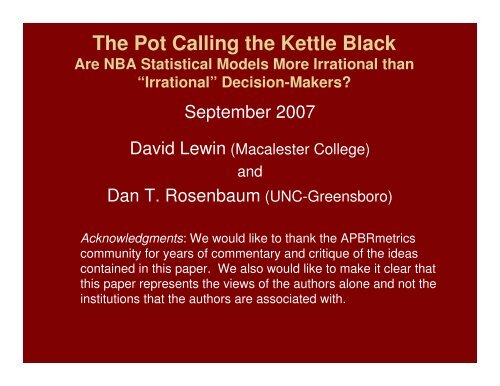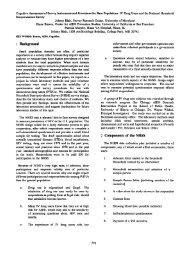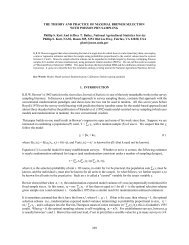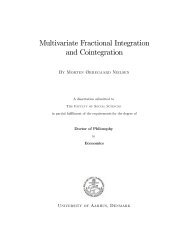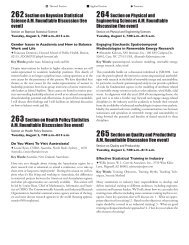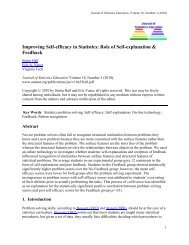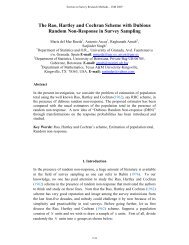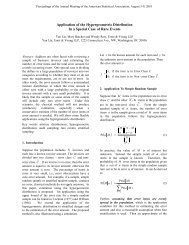The Pot Calling the Kettle Black - American Statistical Association
The Pot Calling the Kettle Black - American Statistical Association
The Pot Calling the Kettle Black - American Statistical Association
Create successful ePaper yourself
Turn your PDF publications into a flip-book with our unique Google optimized e-Paper software.
<strong>The</strong> <strong>Pot</strong> <strong>Calling</strong> <strong>the</strong> <strong>Kettle</strong> <strong>Black</strong><br />
Are NBA <strong>Statistical</strong> Models More Irrational than<br />
“Irrational” Decision-Makers?<br />
September 2007<br />
David Lewin (Macalester College)<br />
and<br />
Dan T. Rosenbaum (UNC-Greensboro)<br />
Acknowledgments: We would like to thank <strong>the</strong> APBRmetrics<br />
community for years of commentary and critique of <strong>the</strong> ideas<br />
contained in this paper. We also would like to make it clear that<br />
this paper represents <strong>the</strong> views of <strong>the</strong> authors alone and not <strong>the</strong><br />
institutions that <strong>the</strong> authors are associated with.
Stats Better than Human Judgment<br />
• Michael Lewis (Moneyball)<br />
• Malcolm Gladwell (review of Wages of Wins)<br />
• David Leonhardt (New York Times)<br />
“Academic research, however, is pretty much on <strong>the</strong> side of<br />
statistics. Whe<strong>the</strong>r diagnosing patients or evaluating job<br />
candidates, human beings vastly overestimate <strong>the</strong>ir ability to<br />
make judgments, research shows. Numbers and analysis almost<br />
always make people better.<br />
‘<strong>The</strong>re have been hundreds of papers on subjects from picking<br />
students for a school to predicting <strong>the</strong> survival of cancer patients,’<br />
said Richard Thaler, a University of Chicago economist who uses<br />
sports examples in his class on decision-making. When a<br />
computer model is given <strong>the</strong> same information as an expert, <strong>the</strong><br />
model almost always comes out on top, Thaler said.”<br />
(Leonhardt, 2005).
Are NBA Decision-Makers Rational?<br />
• David Berri et al. (Wages of Wins, 2006, p. 199)<br />
“Our story of <strong>the</strong> overrated and underrated indicates that <strong>the</strong> NBA<br />
may have a problem evaluating talent. <strong>The</strong> overrated players can<br />
all score, and most of <strong>the</strong>se players have also scored major<br />
paydays. . . All of this suggests that people making decisions in<br />
<strong>the</strong> NBA are not as “rational” as economists tend to expect.”<br />
• Dan Rosenbaum (New York Times, 2005)<br />
“Teams pay for little more than <strong>the</strong> glory statistics (points,<br />
rebounds and, to a lesser extent, assists). . . Although steals,<br />
blocks, shooting percentage and an ability to avoid turnovers are<br />
crucial to a team’s performance, players proficient in <strong>the</strong>se<br />
aspects are rarely rewarded with bigger paychecks.”
NBA Production Functions<br />
• “When a computer model is given <strong>the</strong> same<br />
information as an expert, <strong>the</strong> model almost always<br />
comes out on top, Thaler said.” (Leonhardt, 2005).<br />
• Does <strong>the</strong> computer model ever have <strong>the</strong> “same<br />
information” as <strong>the</strong> expert?<br />
– In baseball that may be close to true.<br />
– In basketball probably not, given <strong>the</strong> difficulties of apportioning<br />
credit (although this is a problem for <strong>the</strong> expert too) and <strong>the</strong><br />
lack of data on things like setting a good pick, playing help<br />
defense, and spreading <strong>the</strong> court.<br />
– Advanced statistical models often do much worse than <strong>the</strong><br />
naïve models of NBA decision-making.
NBA Production Functions Cont.<br />
• How do we model NBA decision-making, i.e. what is<br />
<strong>the</strong> production function <strong>the</strong>y have in mind?<br />
– Minutes per Game<br />
– Points per Game<br />
– NBA Efficiency (add up good things and subtracts bad things)<br />
– Add in team adjustment<br />
• What are <strong>the</strong> alternative production functions that<br />
statistical analysts assume?<br />
– Wins Produced: assumes team production function is<br />
applicable to individual players<br />
– PER: a more careful and reasoned weighting of good and bad<br />
things<br />
– Adjusted Plus/Minus: a non-box score metric
Adjusted Plus/Minus<br />
• Measures how <strong>the</strong> point differential changes when a<br />
given player is in <strong>the</strong> game, holding <strong>the</strong> effects of <strong>the</strong><br />
o<strong>the</strong>r players (on both teams) constant.<br />
• In <strong>the</strong>ory this should pick up almost all of <strong>the</strong><br />
contributions a player makes, including picks, good<br />
defense, spreading <strong>the</strong> floor, etc.<br />
• Not widely used because of difficulty of computing.<br />
– Games are broken down into all of <strong>the</strong> combinations of players<br />
from both teams (over 182,000 combinations between 2002-03<br />
and 2006-07).<br />
– Can’t be easily done in Excel and requires solid understanding of<br />
regression.
Adjusted Plus/Minus Continued<br />
DIFF = β 0 + β 1X 1 + β 2X 2 + . . . + β KX K + ε, where<br />
• DIFF = home team minus away team points per possession.<br />
• X i = 1 if player i is playing at home, = -1 if player i is playing away,<br />
= 0 o<strong>the</strong>rwise (i.e. if player i is not playing),<br />
• ε = i.i.d. error term,<br />
• β 0 measures <strong>the</strong> average home court advantage across all teams,<br />
• β 1 , β 2 , . . . , β K measure how <strong>the</strong> team point differential changes<br />
when a particular player is on <strong>the</strong> court (relative to <strong>the</strong> reference<br />
players), holding <strong>the</strong> effects of o<strong>the</strong>r players (on both teams)<br />
constant.<br />
– <strong>The</strong> reference players are all players playing less than 250<br />
minutes in a given season.
Table 1<br />
Correlations of Player Metrics with Box Score Statistics<br />
Correlation Coefficient (Standard Error)<br />
Per 40 Minute Statistics<br />
Player Metric<br />
PTS TSA REB AST TO STL BLK<br />
Minutes per Game (MPG) with team 0.466 0.403 0.122 0.352 0.111 0.048 0.096<br />
adjustment<br />
(0.029) (0.031) (0.044) (0.038) (0.048) (0.033) (0.044)<br />
Points per Game (PPG) with team 0.846 0.801 0.099 0.402 0.401 0.048 0.069<br />
adjustment<br />
(0.019) (0.025) (0.057) (0.068) (0.054) (0.051) (0.051)<br />
NBA Efficiency (EFF) with position 0.724 0.631 0.488 0.508 0.368 0.216 0.294<br />
and team adjustments<br />
(0.045) (0.050) (0.059) (0.069) (0.060) (0.050) (0.052)<br />
Player Efficiency Rating (PER) with 0.833 0.744 0.327 0.483 0.382 0.187 0.237<br />
position and team adjustments (0.035) (0.043) (0.063) (0.071) (0.062) (0.049) (0.054)<br />
Wins Produced (WP) with position 0.301 0.181 0.684 0.401 0.050 0.287 0.352<br />
and team adjustments<br />
(0.062) (0.063) (0.045) (0.062) (0.062) (0.048) (0.055)<br />
Alt. Wins Produced (AWP) with 0.590 0.468 0.419 0.446 0.116 0.252 0.270<br />
position and team adjustments (0.048) (0.053) (0.058) (0.063) (0.063) (0.043) (0.056)<br />
Adjusted Plus/Minus (+/-) 0.400 0.349 0.126 0.335 0.166 0.162 0.112<br />
(0.039) (0.043) (0.051) (0.046) (0.037) (0.037) (0.054)<br />
• MPG, PPG, EFF, and PER all give scoring a lot of weight.<br />
WP give a lot more weight on rebounds than o<strong>the</strong>r metrics.<br />
Correlation coefficients for +/- similar to those for PPG.<br />
Note that per 40 minute statistics are position-adjusted.<br />
Team<br />
EFF<br />
0.654<br />
(0.011)<br />
0.311<br />
(0.009)<br />
0.329<br />
(0.007)<br />
0.242<br />
(0.009)<br />
0.341<br />
(0.009)<br />
0.373<br />
(0.008)<br />
0.115<br />
(0.017)
Putting Stats to <strong>the</strong> Test<br />
• Explaining current team wins using current metrics.<br />
– With team adjustments, this tells us nothing.<br />
• Predicting current team wins using past metrics.<br />
– Assume that metrics give per minute productivity.<br />
– Assume minutes played can be perfectly predicted.<br />
– Assume perfect prediction for low minutes players/rookies.<br />
– Predicting wins from 1980-81 through 2006-07 seasons.<br />
• Predicting current adjusted plus/minus using past<br />
metrics.<br />
– More powerful test than using team wins.<br />
– Predicting +/- from 2002-03 through 2006-07 seasons.
Table 2<br />
Correlations of Player Metrics with Team Wins and +/-<br />
Correlation Coefficient (Standard Error)<br />
Adjustments Predicting<br />
Player Metric<br />
Pos. Team Wins +/-<br />
Player Efficiency Rating (PER) Yes Yes 0.805 0.492<br />
(0.022) (0.043)<br />
Alt. Wins Produced (AWP) Yes Yes 0.826 0.457<br />
(0.020) (0.040)<br />
NBA Efficiency (EFF)<br />
Yes Yes 0.818 0.479<br />
(0.021) (0.040)<br />
Points per Game (PPG)<br />
No Yes 0.818 0.456<br />
(0.020) (0.039)<br />
Minutes per Game (MPG) No Yes 0.823 0.351<br />
(0.017) (0.023)<br />
Wins Produced (WP)<br />
Yes Yes 0.801 0.372<br />
(0.023) (0.048)<br />
Adjusted Plus/Minus (+/-) No No 0.102 0.267<br />
(0.016) (0.033)<br />
Correlation coefficients for player metrics that are significantly different<br />
from Wins Produced at <strong>the</strong> 5% (1%) level are in italics (bold).
• Berri et al. 2006, p. 215<br />
Conclusion<br />
“One can play basketball. One can watch basketball. One can<br />
both play and watch basketball for a thousand years. If you do<br />
not systematically track what <strong>the</strong> players do, and <strong>the</strong>n uncover <strong>the</strong><br />
statistical relationship between <strong>the</strong>se actions and wins, you will<br />
never know why teams win and why teams lose. Staring at <strong>the</strong>se<br />
players play is not a method that will ever yield <strong>the</strong> answers that<br />
<strong>the</strong> proper analysis of statistics will yield. And this is true if stare<br />
for one day, or as we said, if you stare for a thousand years.”<br />
• One lesson is that we should have some evidence<br />
before making a claim like this one from Berri et al.<br />
• But <strong>the</strong> bigger lesson is that NBA statistical analysts<br />
can make contributions, but only if we realize that our<br />
models can be worse than “staring.”
Table 3<br />
Top 10 Lists for 2005-06<br />
MPG PPG PER EFF<br />
1 Dirk Nowitzki Kobe Bryant Kobe Bryant Dwyane Wade<br />
2 Tim Duncan LeBron James Dwyane Wade Kevin Garnett<br />
3 Tony Parker Allen Iverson LeBron James Kobe Bryant<br />
4 Bruce Bowen Dirk Nowitzki Dirk Nowitzki LeBron James<br />
5 Jason Terry Dwyane Wade Yao Ming Yao Ming<br />
6 Chauncey Billups Gilbert Arenas Kevin Garnett Dirk Nowitzki<br />
7 Pau Gasol Carmelo Anthony Elton Brand Elton Brand<br />
8 Dwyane Wade Paul Pierce Shaquille O'Neal Tim Duncan<br />
9 Shawn Marion Vince Carter Allen Iverson Shawn Marion<br />
10 LeBron James Michael Redd Manu Ginobili Shaquille O'Neal<br />
WP AWP +/-<br />
1 Kevin Garnett Kevin Garnett Ray Allen<br />
2 Jason Kidd Dirk Nowitzki Kobe Bryant<br />
3 Shawn Marion Dwyane Wade Andre Miller<br />
4 Marcus Camby Elton Brand Ben Wallace<br />
5 Ben Wallace LeBron James LeBron James<br />
6 Dwyane Wade Kobe Bryant Jason Richardson<br />
7 Tim Duncan Shawn Marion Mehmet Okur<br />
8 Jeff Foster Manu Ginobili Dwight Howard<br />
9 Manu Ginobili Jason Kidd Rasheed Wallace<br />
10 Steve Nash Steve Nash Vince Carter


